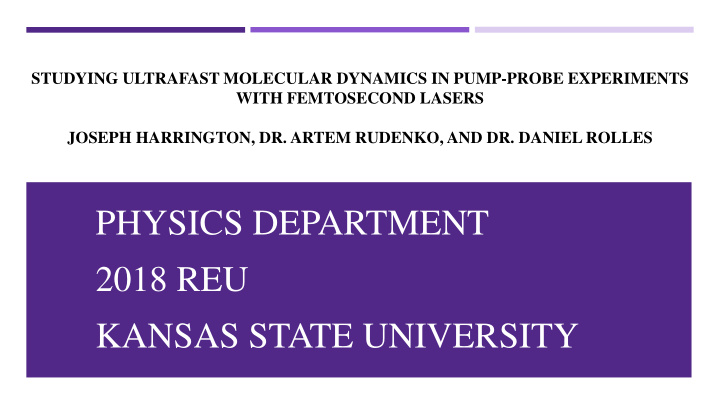



STUDYING ULTRAFAST MOLECULAR DYNAMICS IN PUMP-PROBE EXPERIMENTS WITH FEMTOSECOND LASERS JOSEPH HARRINGTON, DR. ARTEM RUDENKO, AND DR. DANIEL ROLLES PHYSICS DEPARTMENT 2018 REU KANSAS STATE UNIVERSITY
MOTIVATION FOR RESEARCH S. Deb and P.M. Weber, “The Further understanding Ultrafast Pathway of Photon- Induced Electrocyclic Ring- Optimize reactions Opening Reactions: The Case of 1,3- Cyclohexadiene“ , Annual Faster electronics Review of Physical Chemistry 62 , 19 (2011). Iodomethane J. Durá, R. de Nalda, G. A. Amaral, and L. Bañares, “ Imaging transient species in the femtosecond A-band photodissociation of CH 3 I“, J. Chem. Phys. 131 , 134311 (2009).
OPTICAL SET -UP EXPERIMENT SETUP
DELAY STAGE FOR TEMPORAL OVERLAPPING
ISOMERIZATION OF CYCLOHEXADIENE (CHD) Excite CHD molecule with single photon UV Within 100 fs or less after excitation CHD reaches the conical intersection. Short pulses are required to be able to analyze the event effectively. Bucksbaum and Petrovic Faraday Discuss ., 163 , 475 – 484 (2013)
3 RD HARMONIC GENERATION 𝑑 = 𝜇𝜉 First we double the frequency of the IR beam Using sum frequency generation, we can “beat” the two frequencies together Frequency and wavelength are indirectly proportional Causes a positive group delay dispersion (GDD)
USING PRISM COMPRESSOR TO COMPENSATE FOR GDD 𝛍 𝟒 𝐞 𝟑 𝐨 𝐇𝐄𝐄 = ∗ 𝐌 𝐝 𝟑𝛒𝐝 𝟑 𝐞𝛍 𝟑 R. Trebino et. al ., Review of Scientific Instruments 68(9) , 32777 (1997) The speed of light in most materials is different for different • wavelengths http://frog.gatech.edu/pulse-compression.html • When light travels through a medium the different colors composing the pulse arrive at different times (stretched pulse) 𝟑 𝛍 𝟒 + 𝟓 𝒆 𝟑 𝒐 • We make each color travel a slightly longer or shorter path length, 𝟑𝛒𝐝 𝟑 −𝟓𝐦 𝟑 𝐞𝐨 𝐇𝐄𝐄 𝐪𝐬𝐣𝐭𝐧 = 𝟑𝐄 𝒇 −𝟑 such that they all arrive at the same time again 𝒆𝝁 𝟑 𝒆𝝁
CHECKING THE COMPENSATION WITH DFG Cross-correlation Frequency Resolved Optical Gating
CHARACTERIZATION OF OUR PULSES
CONCLUSION Now that we have the characterization of the UV pulse we can send the laser into our COLTRIMS setup to analyze the cyclohexadiene molecule. Using the known strength of the electric field, time of flight, mass divided by the charge of the ion, and the final position of the ion, we hope to be able to reconstruct what the molecule looked like before the reaction. Begin to look at the kinetic energy of the fragments as a function of delay and separate low kinetic energy groups from high ones. Might allow us to determine the charge of CHD right before fragmentation.
ACKNOWLEDGEMENTS I would like to thank Daniel, Artem, Kurtis, and Farzaneh for allowing me to observe, understand, and learn the research process. Also, the NSF for funding this research opportunity. Finally, the other REU students for making the time here memorable.
TIME OF FLIGHT Photodiode around the beam path is the trigger to start the time Microchannel plate is the trigger to stop the time Ion Spectrometer Using kinematic equations we can solve for time 𝐺 = 𝑛𝑏 𝐺 = 𝑟𝐹 𝑨 − 𝑨 0 = 1 2 𝑏 𝑨 𝑢 2 + 𝑤 𝑨0 𝑢 Z 2𝑨 𝑛 𝐹 ∙ 𝑟 = 𝑢 Y
IDENTIFYING FRAGMENTS C 6 H 8 + C 6 H 8 ++ 𝑛 1 𝑈. 𝑃. 𝐺 1 = 𝐷 + 𝑢 0 𝑟 1 Counts 𝑛 2 𝑈. 𝑃. 𝐺 2 = 𝐷 + 𝑢 0 𝑟 2 ToF (ns)
POSITION OF THE FRAGMENTS The position sensitive detector is a double spiral wire around a ceramic plate Time detectors on each of the four corners Using the time it takes a signal to reach the four corners
FRAGMENT TIME OF FLIGHTS AND ASSOCIATED POSITIONS
Recommend
More recommend